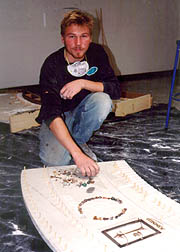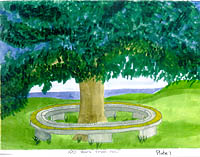
December 11, 2000
Public art blooms at the Children's Garden
Thanks to an inspired engineer-turned-artist, what could have been a routine class
assignment has instead produced a lasting piece of elegant public art for the Life
Lab Science Program's Garden Classroom at the UCSC Farm.
 |
| UCSC sophomore Evan Holm, 20, works in the studio preparing to cast a segment
of the concrete bench he designed for the Life Lab Science Program's Garden Classroom.
Photo by: Jennifer McNulty |
In collaboration with Life Lab, Nagasawa assigned her students the task of designing a work of art for the garden. A five-member jury heard the proposals and selected Holm's project for construction.
The handcrafted circular concrete bench, 16 feet in diameter, will be permanently installed next spring around the seedling of a native oak tree. Carved in the bench surface, three concentric circles mark--from the center outward--the 300-year life span of the oak tree, the four seasons of nature, and the days of a single year.
The bench--made up of eight 400-pound arcs of cast concrete and brass--is designed to be educational as well as beautiful. The surface has been adorned with brass compass points, a children's recipe for Native American acorn mush (complete with an indentation for pounding acorns), an explanation of photosynthesis, an Ohlone poem, and whimsical elements such as pennies and smooth, colorful glass shards that accent the bench.
An integral part of the project is the oak seedling, the slow growth of which inspired Holm to encourage visitors to reflect on history and the future.
 |
| Bench designer Evan Holm painted this illustration of how his bench will look when the oak tree is mature. |
The new children's garden, funded in part by the Packard Foundation, is slated to begin construction early in 2001. Erika Perloff, education coordinator for the Garden Classroom, initially approached Nagasawa, asking if she would design a piece for the garden. It was Nagasawa who suggested making it a public art competition for the students.
During the design process, students had to consider the needs stipulated by Life Lab, including that the artwork be educational, vandalproof, and safe.
With $500 from Life Lab and a $500 Irwin Project Grant that Holm secured himself with Art Department assistance, Holm worked tirelessly to see the project through. Members of the class pitched in, too, and Nagasawa stayed until 5 a.m. to oversee construction on the day before Open Studios on campus. Even Holm's parents, who visited from Seattle over Thanksgiving, were "put to work."
One of the great strengths of the bench, currently in a temporary location outside the Life Lab offices at the UCSC Farm, is that it embodies the best aspect of "functional public art by engaging the public at a very human level with cultural references," said Nagasawa.
"The concept of this project was very strong," she said. "It will enhance the experience of visiting the garden and provide an educational narrative while acknowledging and reinforcing ecological awareness. The work is not just an 'aesthetic object' created for a physical site, but a symbolic connector that will play an integral role in Life Lab's new children's garden, providing a vital link to the past and to the future."
The underlying theme of time, which will be reinforced by the growth of the tree, gives the piece a "four-dimensional quality," Nagasawa added. The outside ring of the bench is made up of small brass plaques, on which each farmer caretaker will annually engrave a significant event that took place during the previous 12 months. Holm and his classmates participated by creating "hypothetical history," engraving a number of plates with their own speculations, including the election of the first woman president in 2008, the birth of "The United Nation of Earth" in 2150, and the abolition of global nuclear testing in 2320.
"As people add their words as the years go by, it will become a growing public art," said Nagasawa. In addition, the Life Lab staff will mark the passage of time by hammering a small brass peg in the innermost ring of the bench.
Gail Thomson, project director of Life Lab's Garden Classroom, is thrilled by the bench, which she said far exceeded her expectations. Indeed, her sentiment is shared by all members of the five-member jury, which included the two landscape architects from the office of Joni Janecki and Associates, who designed the Garden Classroom.